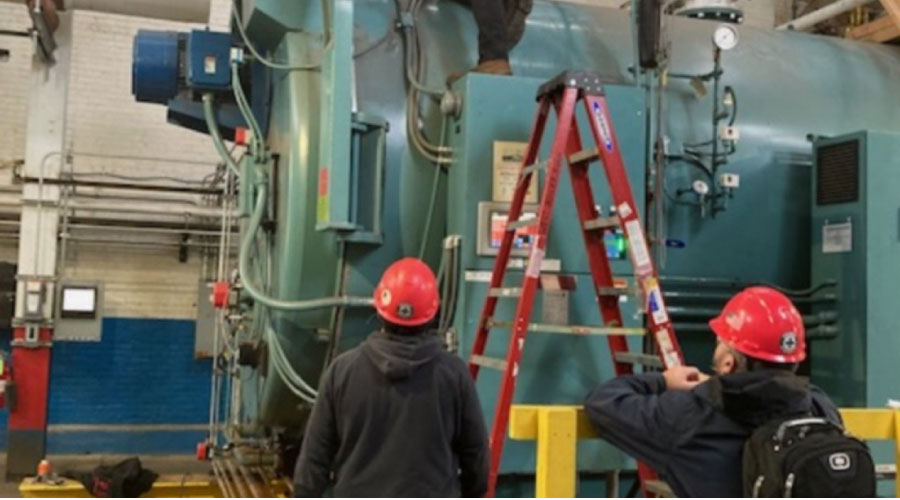 The 1.8-million-square-foot Washington Headquarters Services building in Alexandria, Va., achieved LEED Gold in part because of demand control ventilation and its extensive DDC system. Envise
The 1.8-million-square-foot Washington Headquarters Services building in Alexandria, Va., achieved LEED Gold in part because of demand control ventilation and its extensive DDC system. Envise Benefits of HVAC Direct Digital Controls Systems
From increased comfort to reduced downtime, DDCs provide many advantages for facility managers.
Existing HVAC DDC systems and building solutions provide the ability to implement IoT applications and strategies today. As mentioned, Building IoT strategies can be put into two broad categories: control with automation and information to allow for analysis. Facility managers can implement Building IoT strategies to increase comfort, decrease operating cost, reduce downtime risk, and increase safety. Taking advantage of the Building IoT is a crucial strategy for high performance buildings.
• Increased comfort. Facility comfort can be greatly increased with simple IoT strategies. For example, use existing sensor networks to create graphic visualizations that allow quick and timely environmental changes. Traditionally, this has been done with just a simple measurement of temperature. Expanding the sensors integrated, to include lighting, security, or automated shades, allows for an increased ability to provide comfort to occupants in real time.
• Decreased operating cost. As a standard, today’s commercial facilities deploy sensors that measure the resources required for operation. Many of these sensors are installed as needed to address a specific requirement (e.g., electrical meters in a building). These stand-alone systems have the potential to be integrated into the existing DDC systems and allow for real-time analysis on a large scale. With software, the combined data can be analyzed as an entire systems, giving a much more powerful picture of operations. Operating recommendations that reduce cost and prioritize repairs with return on investment data can then be generated. Thanks to the Building IoT, the analysis happens in an ongoing environment on a scale that was not previously possible.
• Reduced downtime risk. Facilities are dynamic and active places. Depending on a facility’s use, the impact of downtime can range from inconvenient to life-threatening. Using sensor data and analyzing it to act prior to a critical fault can add to a facility’s ability to reduce downtime risk. Mechanical equipment providers already offer large arrays of sensors on complex equipment as a standard. The sensor data can easily be captured in today’s DDC systems and then utilized to make predictive repair decisions. Another example involves the deployment of analytics software with the ability to detect a fault that would normally go unnoticed, and if it remained, would result in a failure due to improper use.
• Increased safety. Allowing people to make decisions and be aware of their surroundings are key to maintaining a safe environment. Life safety and access control systems have developed concurrently with DDC and Internet technologies. Most have been designed and installed to perform stand-alone functions. Today’s DDC systems offer the ability to integrate some, or in many cases, all of these functions (e.g., DDC systems that can provide access control). The integration and convergence of these systems into one Internet-enabled platform can give owners, operators, and occupants real time information, and even be used to control the environment to increase safety. Examples include integrated smoke controls systems in buildings and indoor gun-fire detections systems that utilize sensor arrays placed on existing building networks.
These specific Building IoT strategies can be implemented in facilities with existing DDC systems, and the return on investment is quantifiable; facility managers can prioritize them to meet business requirements.
Future of DDC and IoT
As technology continues to evolve, the potential for additional opportunities will emerge from IoT’s revolution in facilities and HVAC DDC systems — opportunities that will help define the high performance buildings of the future.
Today’s DDC system networks allow for the ability to capture much larger amounts of data from every part of the facility, as well as the integration of hundreds of different types of intelligent systems. The number of sensors and ability to gather large-scale data in facilities will continue to increase, and systems will continue to exchange previously unavailable data with ease. The large increase in available data will provide more visibility into facility conditions, and the behavior of occupants in real-time, thus expanding the ability for increased automation of more complex systems, especially across those once separated.
These new benefits will reduce time-consuming tasks, allowing facility managers and owners more time to focus on critical items. As technology increases in capability and reliability, installation and maintenance will be completed at lower costs.
While the evolution of the Building IoT continues, the potential to model a building in real-time, including features such as automatically adjusting to environmental changes and meeting owner, operator, and occupant needs, will take on an entirely new meaning. The facility will gather data from sensors across many technologies, and analyze and automatically implement changes, optimized in real-time, while simultaneously providing awareness of the environment to those in the facility.
Many facilities today have installed infrastructure within existing HVAC DDC systems to allow implementation of IoT strategies. With the help of an experienced building solution integrator, strategies can be implemented to give a significant return on investment.
Lee Guill is the Mid-Atlantic branch manager at Envise, a national building systems integrator. He can be reached at lguill@enviseco.com.
Email comments to edward.sullivan@tradepress.com.
Related Topics:













